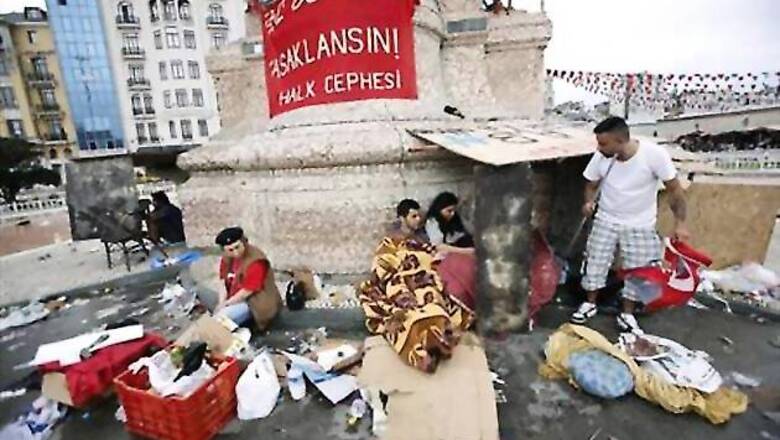
views
Istanbul: Shopkeepers and municipal workers began cleaning the streets of Istanbul and Ankara on Sunday after the fiercest anti-government demonstrations in years.
Pockets of die-hard demonstrators lit bonfires and scuffled with police overnight but the streets were much quieter after two days of clashes in which almost a thousand people were arrested and hundreds were injured.
The unrest was triggered by protests against government plans to build a replica Ottoman-era barracks to house shops or apartments in Taksim, long a venue for political demonstrations.
But it has widened into a broader show of defiance against Prime Minister Tayyip Erdogan and his Islamist-rooted Justice and Development Party (AKP).
On Sunday rain appeared to keep the crowds away from Istanbul's central Taksim Square, where the protests originated, but did not dampen the spirit of a small group of protesters who remained huddled around a bonfire.
Rubble littered the square after days of stand-off between the protesters and Turkish riot police who fired tear gas and water cannon and played cat-and-mouse with them on side streets.
Shopkeepers scrubbed anti-government graffiti off walls. Slogans were also sprayed on burnt-out vehicles including a police car and a bus.
There were calls on social media for further protests on Sunday both in Istanbul and the capital Ankara but it was unclear how many people would turn out.
"We will stay until the end," said Akin, who works in motor trade and has been in Taksim for the past four days.
"We are not leaving. The only answer now is for this government to fall. We are tired of this oppressive government constantly putting pressure on us. This is no longer about these trees," he said, referring to Taksim's Gezi Park which became the focal point of the protests.
FEROCITY
There were more than 90 separate demonstrations around the country on Friday and Saturday, officials said. More than 1,000 people have been injured in Istanbul and several hundred more in Ankara, according to medics.
The ferocity of the police response has shocked Turks, as well as tourists caught up in the unrest in one of the world's most visited destinations. It has drawn rebukes from the United States, European Union and international rights groups.
Helicopters have fired tear gas canisters into residential neighbourhoods and police have used teargas to try to smoke people out of buildings. Footage on YouTube showed one protester being hit by an armoured police truck as it charged a barricade.
Erdogan has overseen a transformation in Turkey during his decade in power, turning its once crisis-prone economy into the fastest-growing in Europe.
He remains by far the most popular politician, but critics point to what they see as his authoritarianism and religiously conservative meddling in private lives in the secular republic.
Tighter restrictions on alcohol sales and warnings against public displays of affection in recent weeks have provoked protests. Concern that government policy is allowing Turkey to be dragged into the conflict in neighbouring Syria by the West has also led to peaceful demonstrations.
Erdogan has called for an immediate end to the latest protests and said his government would investigate allegations the police have used excessive force. But he remained defiant.
"If this is about holding meetings, if this is a social movement, where they gather 20, I will get up and gather 200,000 people. Where they gather 100,000, I will bring together one million from my party," he said in a televised speech.




















Comments
0 comment